Predictability of Intra-Seasonal Descriptors of Rainy Season over Senegal Using Global SST Patterns
Abstract
:1. Introduction
2. Materials and Method
2.1. Study Area
2.2. Data
2.3. Metrics
2.4. Regression Analysis
3. Results
3.1. Spatial Variability of Metrics
3.2. Interannual Variability
3.3. Descriptive Cumulative Distribution Function
3.4. Sst Teleconnection Patterns
4. Summary and Discussion
Author Contributions
Funding
Institutional Review Board Statement
Informed Consent Statement
Data Availability Statement
Acknowledgments
Conflicts of Interest
Abbreviations
| ARC | African Risk Capacity |
| CDD | Consecutive Dry Days |
| CDD7 | Consecutive Dry Days 7days |
| CDD15 | Consecutive Dry Days 15 days |
| CHIRPS | Climate Hazards Group InfraRed Precipitation with Station |
| CV | coefficient of variation |
| ETCCDI | Expert Team on Climate Change Detection and Indices |
| ENSO | El Niño–Southern Oscillation |
| HadISST | Hadley centre global sea Ice and Sea Surface Temperature |
| ITCZ | Inter Tropical Convergence Zone |
| JAS | July August September |
| JFM | January February March |
| LRS | Length of Rainy Season |
| NR90p | Wet day with rainfall amount 90th percentile |
| NR95p | Wet day with rainfall amount 95th percentile |
| NR99p | Wet day with rainfall amount 99th percentile |
| SST | Sea surface temperature |
| WAM | West African monsoon |
| WFP | World Food Program |
References
- Toure, A.K.; Diakhaté, M.; Thierno Gaye, A.; Diop, M.; Ndiaye, O. Sensivity of Crop Yields to Temperature and Rainfall Daily Metrics in Senegal. Am. J. Rural. Dev. 2020, 8, 1–11. [Google Scholar] [CrossRef]
- Diallo, M.D.; Wood, S.A.; Diallo, A.; Mahatma-Saleh, M.; Ndiaye, O.; Tine, A.K.; Ngamb, T.; Guisse, M.; Seck, S.; Diop, A.; et al. Soil suitability for the production of rice, groundnut, and cassava in the peri-urban Niayes zone, Senegal. Soil Tillage Res. 2016, 155, 412–420. [Google Scholar] [CrossRef]
- Sultan, B.; Defrance, D.; Iizumi, T. Evidence of crop production losses in West Africa due to historical global warming in two crop models. Sci. Rep. 2019, 9, 12834. [Google Scholar] [CrossRef] [PubMed]
- Roudier, P.; Kane, C.; Leblois, A.; Sultan, B.; Weber, S. Deux Exemples de Stratégies de Gestion du Risque Agricole en Afrique de l’Ouest: Services Climatiques et Assurances Indicielles. 2019. Available online: http://antoine.leblois.free.fr/chapitre_conference_GSA_v7.pdf (accessed on 25 August 2022).
- WMO. The Global Climatein 2015–2019; World Meteorological Organization: Geneva, Switzerland, 2015. [Google Scholar]
- ARC. Republic of Senegal Final Implementation Plan November 2014; The African Risk Capacity (ARC) Group: Johannesburg, South Africa, 2014. [Google Scholar]
- WFP. WFP Senegal Country Brief 2018; World Food Programme: Rome, Italy, 2018. [Google Scholar]
- Lamb, P.J. Large-scale tropical Atlantic surface circulation patterns associated with Subsaharan weather anomalies. Tellus 1978, 30, 240–251. [Google Scholar] [CrossRef]
- Nicholson, S.E. Revised rainfall series for the West African subtropics. Mon. Weather. Rev. 1979, 107, 620–623. [Google Scholar] [CrossRef]
- Nicholson, S.; Chervin, R. Recent Rainfall Fluctuations in Africa—Interhemispheric Teleconnections; Springer: Dordrecht, The Netherlands, 1983; pp. 221–238. [Google Scholar]
- Fontaine, B.; Louvet, S.; Roucou, P. Definition and predictability of an OLR-based West African monsoon onset. Int. J. Climatol. 2008, 28, 1787–1798. [Google Scholar] [CrossRef]
- Drobinski, P.; Sultan, B.; Janicot, S. Role of the Hoggar massif in the West African monsoon onset. Geophys. Res. Lett. 2005, 32. [Google Scholar] [CrossRef]
- Lavaysse, C.; Flamant, C.; Janicot, S.; Parker, D.J.; Lafore, J.P.; Sultan, B.; Pelon, J. Seasonal evolution of the West African heat low: A climatological perspective. Clim. Dyn. 2009, 33, 313–330. [Google Scholar] [CrossRef]
- Nicholson, S.E. Sub-saharan rainfall 1981–1984. J. Clim. Appl. Meteorol. 1985, 24, 1388–1391. [Google Scholar] [CrossRef]
- Dieng, O.; Roucou, P.; Louvet, S. Variabilité intra-saisonnière des précipitations au Sénégal (1951–1996). Sécheresse 2008, 19, 87–93. [Google Scholar]
- Marteau, R.; Moron, V.; Philippon, N. Spatial Coherence of Monsoon Onset over Western and Central Sahel (1950–2000). J. Clim. 2009, 22, 1313–1324. [Google Scholar] [CrossRef] [Green Version]
- Moron, V.; Robertson, A.W.; Ward, M.N. Seasonal predictability and spatial coherence of rainfall characteristics in the tropical setting of Senegal. Mon. Weather. Rev. 2006, 134, 3248–3262. [Google Scholar] [CrossRef]
- Sagna, P.; Ndiaye, O.; Diop, C.; Niang, A.D.; Sambou, P.C. Les Variations réCentes du Climat Constatées au Sénégal Sont-Elles en Phase Avec les Descriptions Données par les Scénarios du GIEC? 2016. Available online: https://inondations-dakar.org/dataset/les-variations-recentes-du-climat-constatees-au-senegal (accessed on 25 August 2022). [CrossRef]
- Reason, C.; Rouault, M.; Melice, J.L.; Jagadheesha, D. Interannual winter rainfall variability in SW South Africa and large scale ocean—Atmosphere interactions. Meteorol. Atmos. Phys. 2002, 80, 19–29. [Google Scholar] [CrossRef]
- Li, S.; Robinson, W.A.; Peng, S. Influence of the North Atlantic SST tripole on northwest African rainfall. J. Geophys. Res. Atmos. 2003, 108. [Google Scholar] [CrossRef]
- Misra, V. The influence of Pacific SST variability on the precipitation over southern Africa. J. Clim. 2003, 16, 2408–2418. [Google Scholar] [CrossRef]
- Moron, V.; Philippon, N.; Fontaine, B. Skill of Sahel rainfall variability in four atmospheric GCMs forced by prescribed SST. Geophys. Res. Lett. 2003, 30. [Google Scholar] [CrossRef]
- Paeth, H.; Friederichs, P. Seasonality and time scales in the relationship between global SST and African rainfall. Clim. Dyn. 2004, 23, 815–837. [Google Scholar] [CrossRef]
- Janowiak, J.E. An investigation of interannual rainfall variability in Africa. J. Clim. 1988, 1, 240–255. [Google Scholar] [CrossRef]
- Walker, N. Links between South African summer rainfall and temperature variability of the Agulhas and Benguela Current systems. J. Geophys. Res. Ocean. 1990, 95, 3297–3319. [Google Scholar] [CrossRef]
- Jury, M.R.; Valentine, H.R.; Lutjeharms, J.R. Influence of the Agulhas Current on summer rainfall along the southeast coast of South Africa. J. Appl. Meteorol. Climatol. 1993, 32, 1282–1287. [Google Scholar] [CrossRef]
- Mason, S.J. Sea-surface temperature—South African rainfall associations, 1910–1989. Int. J. Climatol. 1995, 15, 119–135. [Google Scholar] [CrossRef]
- Reason, C.; Lutjeharms, J. Variability of the South Indian Ocean and implications for southern African rainfall. S. Afr. J. Sci. 1998, 94, 115–123. [Google Scholar]
- Biasutti, M.; Battisti, D.S.; Sarachik, E. Mechanisms controlling the annual cycle of precipitation in the tropical Atlantic sector in an atmospheric GCM. J. Clim. 2004, 17, 4708–4723. [Google Scholar] [CrossRef]
- Nicholson, S.E.; Dezfuli, A.K. The relationship of rainfall variability in western equatorial Africa to the tropical oceans and atmospheric circulation. Part I: The boreal spring. J. Clim. 2013, 26, 45–65. [Google Scholar] [CrossRef]
- Shinoda, M.; Kawamura, R. Tropical rainbelt, circulation, and sea surface temperatures associated with the Sahelian rainfall trend. J. Meteorol. Soc. Jpn. Ser. II 1994, 72, 341–357. [Google Scholar] [CrossRef]
- Trzaska, S.; Janicot, S. The role of the Indian Ocean in modulation of ENSO impacts on the West African Monsoon. CLIVAR Exch. 2003, 8, 17–18. [Google Scholar]
- Giannini, A.; Saravanan, R.; Chang, P. Oceanic forcing of Sahel rainfall on interannual to interdecadal time scales. Science 2003, 302, 1027–1030. [Google Scholar] [CrossRef]
- Ndiaye, O. The Predictability of the Sahelian Climate: Seasonal Sahel Rainfall and Onset over Senegal; Columbia University: New York, NY, USA, 2010; Volume 72. [Google Scholar]
- Insua-Costa, D.; Senande-Rivera, M.; Llasat, M.C.; Miguez-Macho, G. A global perspective on western Mediterranean precipitation extremes. npj Clim. Atmos. Sci. 2022, 5, 9. [Google Scholar] [CrossRef]
- Donat, M.; Peterson, T.; Brunet, M.; King, A.; Almazroui, M.; Kolli, R.; Boucherf, D.; Al-Mulla, A.Y.; Nour, A.Y.; Aly, A.A.; et al. Changes in extreme temperature and precipitation in the Arab region: Long-term trends and variability related to ENSO and NAO. Int. J. Climatol. 2014, 34, 581–592. [Google Scholar] [CrossRef]
- Diakhaté, M.; Rodríguez-Fonseca, B.; Gómara, I.; Mohino, E.; Dieng, A.L.; Gaye, A.T. Oceanic Forcing on Interannual Variability of Sahel Heavy and Moderate Daily Rainfall. J. Hydrometeorol. 2019, 20, 397–410. [Google Scholar] [CrossRef]
- Taylor, C.M.; Belušić, D.; Guichard, F.; Parker, D.J.; Vischel, T.; Bock, O.; Harris, P.P.; Janicot, S.; Klein, C.; Panthou, G. Frequency of extreme Sahelian storms tripled since 1982 in satellite observations. Nature 2017, 544, 475–478. [Google Scholar] [CrossRef]
- Panthou, G.; Mailhot, A.; Laurence, E.; Talbot, G. Relationship between surface temperature and extreme rainfalls: A multi-time-scale and event-based analysis. J. Hydrometeorol. 2014, 15, 1999–2011. [Google Scholar] [CrossRef]
- Cattani, E.; Merino, A.; Guijarro, J.A.; Levizzani, V. East Africa rainfall trends and variability 1983–2015 using three long-term satellite products. Remote Sens. 2018, 10, 931. [Google Scholar] [CrossRef]
- Funk, C.; Peterson, P.; Landsfeld, M.; Pedreros, D.; Verdin, J.; Shukla, S.; Husak, G.; Rowland, J.; Harrison, L.; Hoell, A.; et al. The climate hazards infrared precipitation with stations—A new environmental record for monitoring extremes. Sci. Data 2015, 2, 150066. [Google Scholar] [CrossRef]
- Roudier, P.; Muller, B.; d’Aquino, P.; Roncoli, C.; Soumaré, M.A.; Batté, L.; Sultan, B. The role of climate forecasts in smallholder agriculture: Lessons from participatory research in two communities in Senegal. Clim. Risk Manag. 2014, 2, 42–55. [Google Scholar] [CrossRef]
- Salack, S.; Muller, B.; Gaye, A.T. Rain-based factors of high agricultural impacts over Senegal. Part I: Integration of local to sub-regional trends and variability. Theor. Appl. Climatol. 2011, 106, 1–22. [Google Scholar] [CrossRef]
- Bodian, A. Caractérisation de la variabilité temporelle récente des précipitations annuelles au Sénégal (Afrique de l’Ouest). Physio-Géo. Géographie Phys. Environ. 2014, 8, 297–312. [Google Scholar] [CrossRef]
- Faye, C.; Sow, A.A.; Ndong, J.B. Étude des sècheresses pluviométriques et hydrologiques en Afrique tropicale: Caractérisation et cartographie de la sècheresse par indices dans le haut bassin du fleuve Sénégal. Physio-Géo. Géographie Phys. Environ. 2015, 9, 17–35. [Google Scholar] [CrossRef]
- Fall, S.; Niyogi, D.; Semazzi, F. Analysis of Mean Climate Conditions in Senegal (1971–98). Earth Interact. 2006, 10, 1–40. [Google Scholar] [CrossRef]
- Funk, C.; Michaelsen, J.; Marshall, M.T. Mapping Recent Decadal Climate Variations in Precipitation and Temperature across Eastern Africa; Remote Sensing of Drought: Innovative Monitoring Approaches; CRC Press: Boca Raton, FL, USA, 2012; pp. 331–358. [Google Scholar] [CrossRef]
- Sacré Regis, M.D.; Mouhamed, L.; Kouakou, K.; Adeline, B.; Arona, D.; Houebagnon Saint, J.C.; Koffi Claude, A.K.; Talnan Jean, H.C.; Salomon, O.; Issiaka, S. Using the CHIRPS Dataset to Investigate Historical Changes in Precipitation Extremes in West Africa. Climate 2020, 8, 84. [Google Scholar] [CrossRef]
- Xie, P.; Joyce, R.; Wu, S.; Yoo, S.H.; Yarosh, Y.; Sun, F.; Lin, R. Reprocessed, bias-corrected CMORPH global high-resolution precipitation estimates from 1998. J. Hydrometeorol. 2017, 18, 1617–1641. [Google Scholar] [CrossRef]
- Huffman, G.J.; Adler, R.F.; Bolvin, D.T.; Nelkin, E.J. The TRMM multi-satellite precipitation analysis (TMPA). In Satellite Rainfall Applications for Surface Hydrology; Springer: Dordrecht, The Netherland, 2010; pp. 3–22. [Google Scholar] [CrossRef]
- Sorooshian, S.; Nguyen, P.; Sellars, S.; Braithwaite, D.; AghaKouchak, A.; Hsu, K. Satellite-based remote sensing estimation of precipitation for early warning systems. Extrem. Nat. Hazards Disaster Risks Soc. Implic. 2014, 1, 99–112. [Google Scholar]
- Bichet, A.; Diedhiou, A. Less frequent and more intense rainfall along the coast of the Gulf of Guinea in West and Central Africa (1981–2014). Clim. Res. 2018, 76, 191–201. [Google Scholar] [CrossRef]
- Rayner, N.; Parker, D.E.; Horton, E.; Folland, C.K.; Alexander, L.V.; Rowell, D.; Kent, E.; Kaplan, A. Global analyses of sea surface temperature, sea ice, and night marine air temperature since the late nineteenth century. J. Geophys. Res. Atmos. 2003, 108, D14. [Google Scholar] [CrossRef]
- Froidurot, S.; Diedhiou, A. Characteristics of wet and dry spells in the West African monsoon system. Atmos. Sci. Lett. 2017, 18, 125–131. [Google Scholar] [CrossRef]
- Bichet, A.; Diedhiou, A. West African Sahel has become wetter during the last 30 years, but dry spells are shorter and more frequent. Clim. Res. 2018, 75, 155–162. [Google Scholar] [CrossRef]
- Sivakumar, M.V.K. Predicting rainy season potential from the onset of rains in southern Sahelian and Sudanian climatic zones of West Africa. Agric. For. Meteorol. 1988, 42, 295–305. [Google Scholar] [CrossRef]
- Stern, R.; Dennett, M.; Garbutt, D. The start of the rains in West Africa. J. Climatol. 1981, 1, 59–68. [Google Scholar] [CrossRef]
- Lebel, T.; Diedhiou, A.; Laurent, H. Seasonal cycle and interannual variability of the Sahelian rainfall at hydrological scales. J. Geophys. Res. Atmos. 2003, 108, 8389. [Google Scholar] [CrossRef]
- Ratan, R.; Venugopal, V. Wet and dry spell characteristics of global tropical rainfall. Water Resour. Res. 2013, 49, 3830–3841. [Google Scholar] [CrossRef]
- Dhonneur, G. Essai de Synthèse sur les Théories des Lignes de Grains en Afrique Occidentale et Centrale; ASECNA Pub: Dakar, Senegal, 1970. [Google Scholar]
- Mahdi Amin Le Roux, E.T. The variability of the pentade rainfall in the Sudan. East Afr. Geogr. Rev. 1973, 1973, 82–87. [Google Scholar]
- Camberlin, P.; Diop, M. Inter-Relationships Between Groundnut Yield in Senegal, Interannual Rainfall Variability and Sea-Surface Temperatures. Theor. Appl. Climatol. 1999, 63, 163–181. [Google Scholar] [CrossRef]
- Sivakumar, M. Empirical analysis of dry spells for agricultural applications in West Africa. J. Clim. 1992, 5, 532–539. [Google Scholar] [CrossRef]
- Trenberth, K.E.; Dai, A.; Rasmussen, R.M.; Parsons, D.B. The changing character of precipitation. Bull. Am. Meteorol. Soc. 2003, 84, 1205–1218. [Google Scholar] [CrossRef]
- Trenberth, K.E. Changes in precipitation with climate change. Clim. Res. 2011, 47, 123–138. [Google Scholar] [CrossRef]
- Diakhaté, M.; Lazar, A.; de Coëtlogon, G.; Gaye, A.T. Do SST gradients drive the monthly climatological surface wind convergence over the tropical Atlantic? Int. J. Climatol. 2018, 38, e955–e965. [Google Scholar] [CrossRef]
- Giannakopoulos, C.; Le Sager, P.; Bindi, M.; Moriondo, M.; Kostopoulou, E.; Goodess, C. Climatic changes and associated impacts in the Mediterranean resulting from a 2 C global warming. Glob. Planet. Chang. 2009, 68, 209–224. [Google Scholar] [CrossRef]
- Huntington, T.G. Evidence for intensification of the global water cycle: Review and synthesis. J. Hydrol. 2006, 319, 83–95. [Google Scholar] [CrossRef]
- Loo, Y.Y.; Billa, L.; Singh, A. Effect of climate change on seasonal monsoon in Asia and its impact on the variability of monsoon rainfall in Southeast Asia. Geosci. Front. 2015, 6, 817–823. [Google Scholar] [CrossRef]
- Fall, C.M.N.; Lavaysse, C.; Drame, M.S.; Panthou, G.; Gaye, A.T. Wet and dry spells in Senegal: Evaluation of satellite-based and model re-analysis rainfall estimates. Nat. Hazards Earth Syst. Sci. Discuss. 2019, 21, 1051–1069. [Google Scholar] [CrossRef]
- Panthou, G.; Lebel, T.; Vischel, T.; Quantin, G.; Sane, Y.; Ba, A.; Ndiaye, O.; Diongue-Niang, A.; Diopkane, M. Rainfall intensification in tropical semi-arid regions: The Sahelian case. Environ. Res. Lett. 2018, 13, 064013. [Google Scholar] [CrossRef]
- Mariotti, L.; Diallo, I.; Coppola, E.; Giorgi, F. Seasonal and intraseasonal changes of African monsoon climates in 21st century CORDEX projections. Clim. Chang. 2014, 125, 53–65. [Google Scholar] [CrossRef]
- Nicholson, S.E. The spatial coherence of African rainfall anomalies: Interhemispheric teleconnections. J. Appl. Meteorol. Climatol. 1986, 25, 1365–1381. [Google Scholar] [CrossRef]
- Ropelewski, C.F.; Halpert, M.S. Global and regional scale precipitation patterns associated with the El Niño/Southern Oscillation. Mon. Weather. Rev. 1987, 115, 1606–1626. [Google Scholar] [CrossRef]
- Rowell, D.P.; Folland, C.K.; Maskell, K.; Ward, M.N. Variability of summer rainfall over tropical North Africa (1906–92): Observations and modelling. Q. J. R. Meteorol. Soc. 1995, 121, 669–704. [Google Scholar]
- Nicholson, S.E.; Kim, J. The relationship of the El Niño–Southern oscillation to African rainfall. Int. J. Climatol. J. R. Meteorol. Soc. 1997, 17, 117–135. [Google Scholar] [CrossRef]
- Janicot, S.; Moron, V.; Fontaine, B. Sahel droughts and ENSO dynamics. Geophys. Res. Lett. 1996, 23, 515–518. [Google Scholar] [CrossRef]
- Janicot, S.; Trzaska, S.; Poccard, I. Summer Sahel-ENSO teleconnection and decadal time scale SST variations. Clim. Dyn. 2001, 18, 303–320. [Google Scholar] [CrossRef]
- Rodríguez-Fonseca, B.; Janicot, S.; Mohino, E.; Losada, T.; Bader, J.; Caminade, C.; Chauvin, F.; Fontaine, B.; García-Serrano, J.; Gervois, S.; et al. Interannual and decadal SST-forced responses of the West African monsoon. Atmos. Sci. Lett. 2011, 12, 67–74. [Google Scholar] [CrossRef]
- Lübbecke, J.F.; Rodríguez-Fonseca, B.; Richter, I.; Martín-Rey, M.; Losada, T.; Polo, I.; Keenlyside, N.S. Equatorial Atlantic variability—Modes, mechanisms, and global teleconnections. Wiley Interdiscip. Rev. Clim. Chang. 2018, 9, e527. [Google Scholar] [CrossRef]
- Rifai, S.W.; Li, S.; Malhi, Y. Coupling of El Niño events and long-term warming leads to pervasive climate extremes in the terrestrial tropics. Environ. Res. Lett. 2019, 14, 105002. [Google Scholar] [CrossRef]
- Bjerknes, J. Atmospheric teleconnections from the equatorial Pacific. Mon. Weather. Rev. 1969, 97, 163–172. [Google Scholar] [CrossRef]
- Cane, M.A.; Clement, A.C.; Kaplan, A.; Kushnir, Y.; Pozdnyakov, D.; Seager, R.; Zebiak, S.E.; Murtugudde, R. Twentieth-century sea surface temperature trends. Science 1997, 275, 957–960. [Google Scholar] [CrossRef] [Green Version]
- Yulaeva, E.; Wallace, J.M. The signature of ENSO in global temperature and precipitation fields derived from the microwave sounding unit. J. Clim. 1994, 7, 1719–1736. [Google Scholar] [CrossRef]
- Chiang, J.C.; Sobel, A.H. Tropical tropospheric temperature variations caused by ENSO and their influence on the remote tropical climate. J. Clim. 2002, 15, 2616–2631. [Google Scholar] [CrossRef]
- Sharon, N.E. On the factors modulating the intensity of the tropical rainbelt over West Africa. Int. J. Climatol. J. R. Meteorol. Soc. 2009, 29, 673–689. [Google Scholar]
- Chiang, J.C.; Vimont, D.J. Analogous Pacific and Atlantic meridional modes of tropical atmosphere-ocean variability. J. Clim. 2004, 17, 4143–4158. [Google Scholar] [CrossRef]
- Lin, Z.H.; Victor Nnamdi, D. Impact of Trans-Atlantic-Pacific Ocean Dipole–like pattern on summer precipitation variability over West Africa. Atmos. Ocean. Sci. Lett. 2018, 11, 509–517. [Google Scholar] [CrossRef]
- Park, J.y.; Bader, J.; Matei, D. Anthropogenic Mediterranean warming essential driver for present and future Sahel rainfall. Nat. Clim. Chang. 2016, 6, 941–945. [Google Scholar] [CrossRef]
- Raicich, F.; Nadia, P.; Navarra, A. Teleconnections between Indian monsoon and Sahel rainfall and the Mediterranean. Int. J. Climatol. J. R. Meteorol. Soc. 2003, 23, 173–186. [Google Scholar] [CrossRef]
- Fontaine, B.; Monerie, P.A.; Gaetani, M.; Roucou, P. Climate adjustments over the African-Indian monsoon regions accompanying Mediterranean Sea thermal variability. J. Geophys. Res. (Atmos.) 2011, 116. [Google Scholar] [CrossRef]
- Fontaine, B.; Pham, X. Modulation of the African-Indian rainfall relationship by the thermal variability over the Mediterranean Sea in northern summer. Int. J. Climatol. 2012, 33, 2744–2757. [Google Scholar] [CrossRef]
- Salack, S.; Giannini, A.; Diakhaté, M.; Gaye, A.T.; Muller, B. Oceanic influence on the sub-seasonal to interannual timing and frequency of extreme dry spells over the West African Sahel. Clim. Dyn. 2014, 42, 189–201. [Google Scholar] [CrossRef]
- Salack, S.; Klein, C.; Giannini, A.; Sarr, B.; Worou, O.N.; Belko, N.; Bliefernicht, J.; Kunstman, H. Global warming induced hybrid rainy seasons in the Sahel. Environ. Res. Lett. 2016, 11, 104008. [Google Scholar] [CrossRef]
- Alpert, P.; Baldi, M.; Ilani, R.; Krichak, S.; Price, C.; Rodó, X.; Saaroni, H.; Ziv, B.; Kishcha, P.; Barkan, J.; et al. Chapter 2 Relations between climate variability in the Mediterranean region and the tropics: ENSO, South Asian and African monsoons, hurricanes and Saharan dust. Dev. Earth Environ. Sci. 2006, 4, 149–177. [Google Scholar] [CrossRef]
- Westra, S.; Fowler, H.J.; Evans, J.P.; Alexander, L.V.; Berg, P.; Johnson, F.; Kendon, E.J.; Lenderink, G.; Roberts, N.M. Future changes to the intensity and frequency of short-duration extreme rainfall. Rev. Geophys. 2014, 52, 522–555. [Google Scholar] [CrossRef]
- Fischer, E.M.; Knutti, R. Detection of spatially aggregated changes in temperature and precipitation extremes. Geophys. Res. Lett. 2014, 41, 547–554. [Google Scholar] [CrossRef]
- Saffioti, C.; Fischer, E.M.; Scherrer, S.C.; Knutti, R. Reconciling observed and modeled temperature and precipitation trends over Europe by adjusting for circulation variability. Geophys. Res. Lett. 2016, 43, 8189–8198. [Google Scholar] [CrossRef]
- Donat, M.G.; Lowry, A.L.; Alexander, L.V.; O’Gorman, P.A.; Maher, N. More extreme precipitation in the world’s dry and wet regions. Nat. Clim. Chang. 2016, 6, 508–513. [Google Scholar] [CrossRef]
- Fischer, E.M.; Knutti, R. Observed heavy precipitation increase confirms theory and early models. Nat. Clim. Chang. 2016, 6, 986–991. [Google Scholar] [CrossRef]
- Min, S.K.; Zhang, X.; Zwiers, F.W.; Hegerl, G.C. Human contribution to more-intense precipitation extremes. Nature 2011, 470, 378–381. [Google Scholar] [CrossRef] [PubMed]
- Zhao, Y.; Zhang, J.; Nielsen, C.P. The effects of recent control policies on trends in emissions of anthropogenic atmospheric pollutants and CO2 in China. Atmos. Chem. Phys. 2013, 13, 487–508. [Google Scholar] [CrossRef]
- Giorgi, F.; Im, E.S.; Coppola, E.; Diffenbaugh, N.S.; Gao, X.J.; Mariotti, L.; Shi, Y. Higher Hydroclimatic Intensity with Global Warming. J. Clim. 2011, 24, 5309–5324. [Google Scholar] [CrossRef]
- Jianping, L.; Qingcun, Z. A new monsoon index and the geographical distribution of the global monsoons. Adv. Atmos. Sci. 2003, 20, 299–302. [Google Scholar] [CrossRef]
- Nnamchi, H.C.; Li, J. Influence of the South Atlantic Ocean Dipole on West African Summer Precipitation. J. Clim. 2011, 24, 1184–1197. [Google Scholar] [CrossRef]
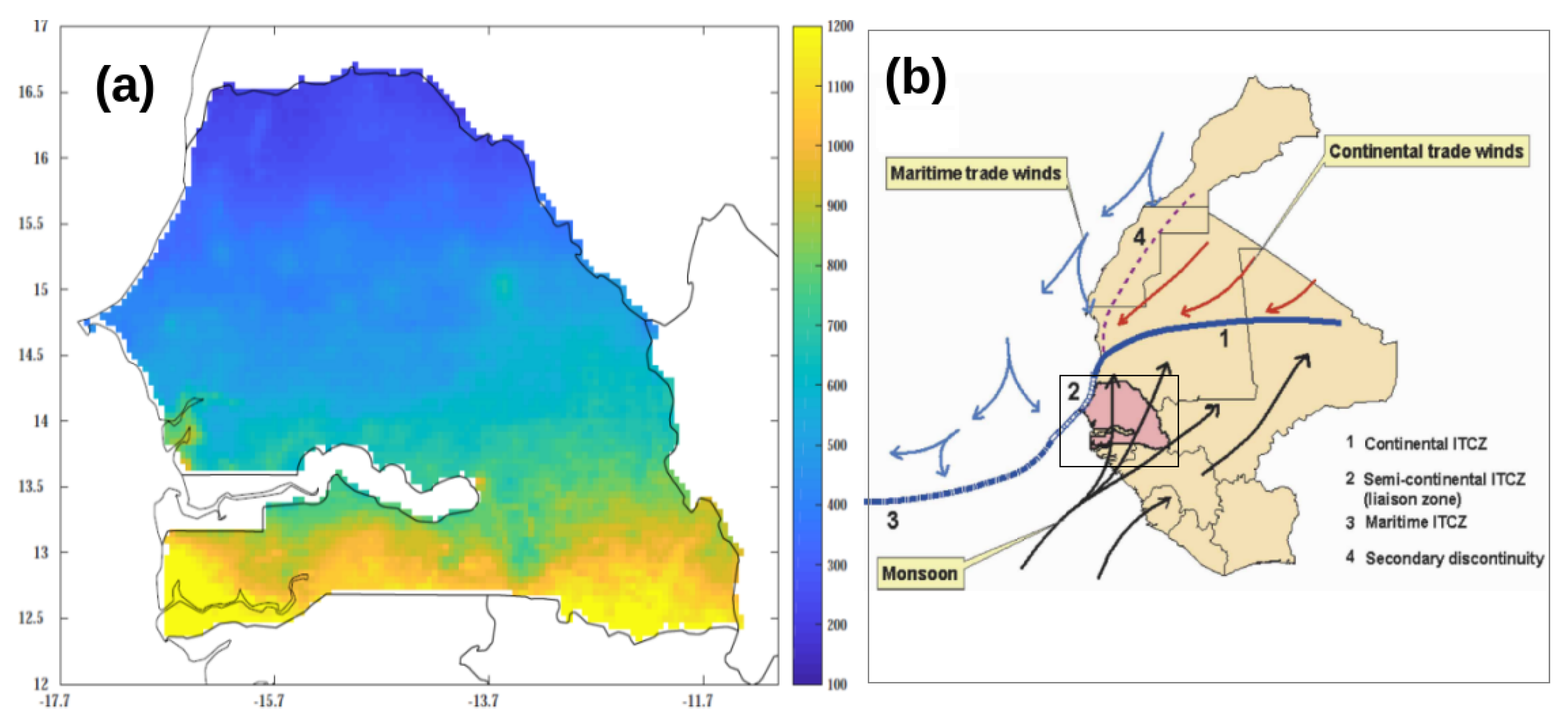

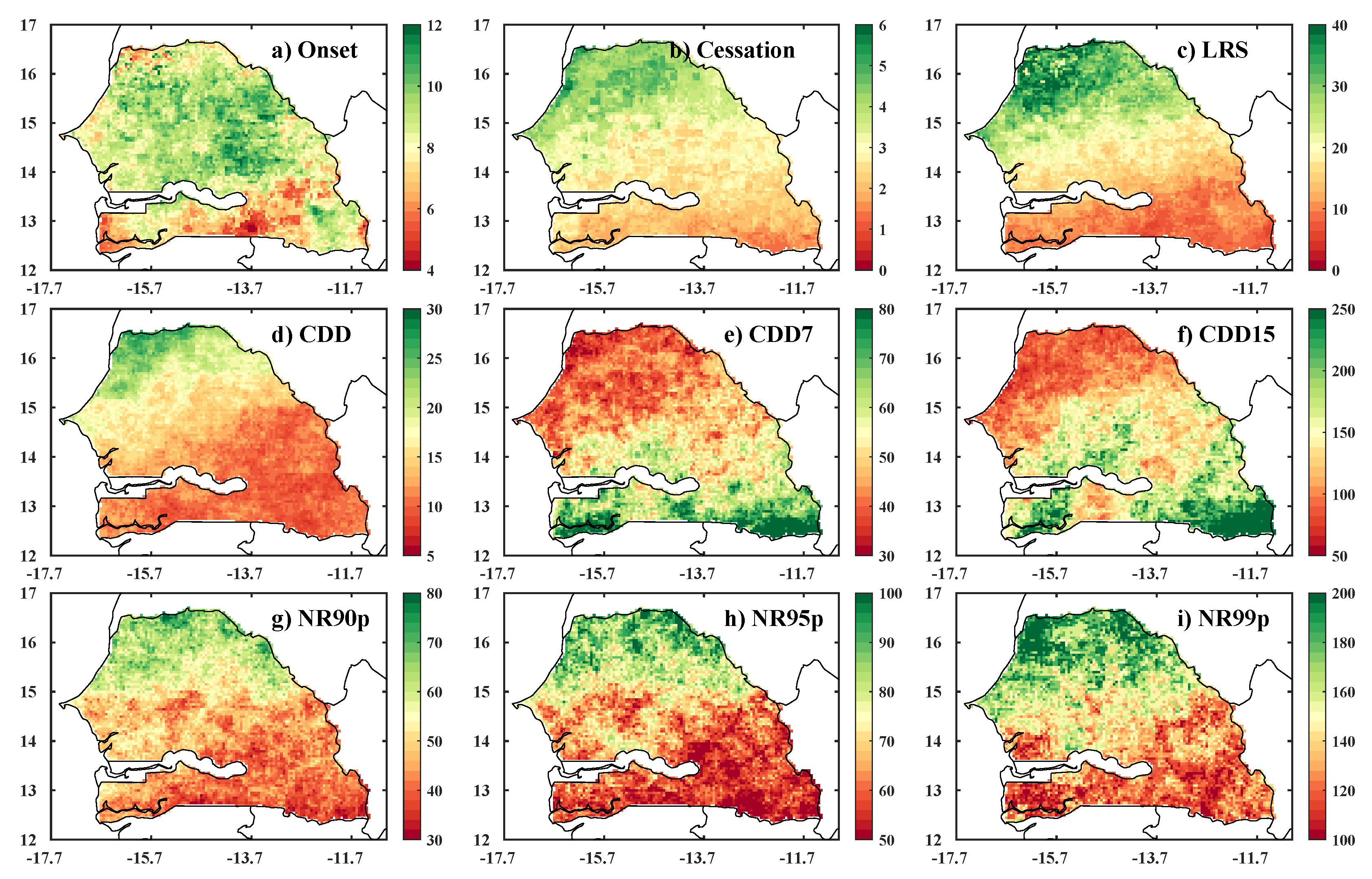
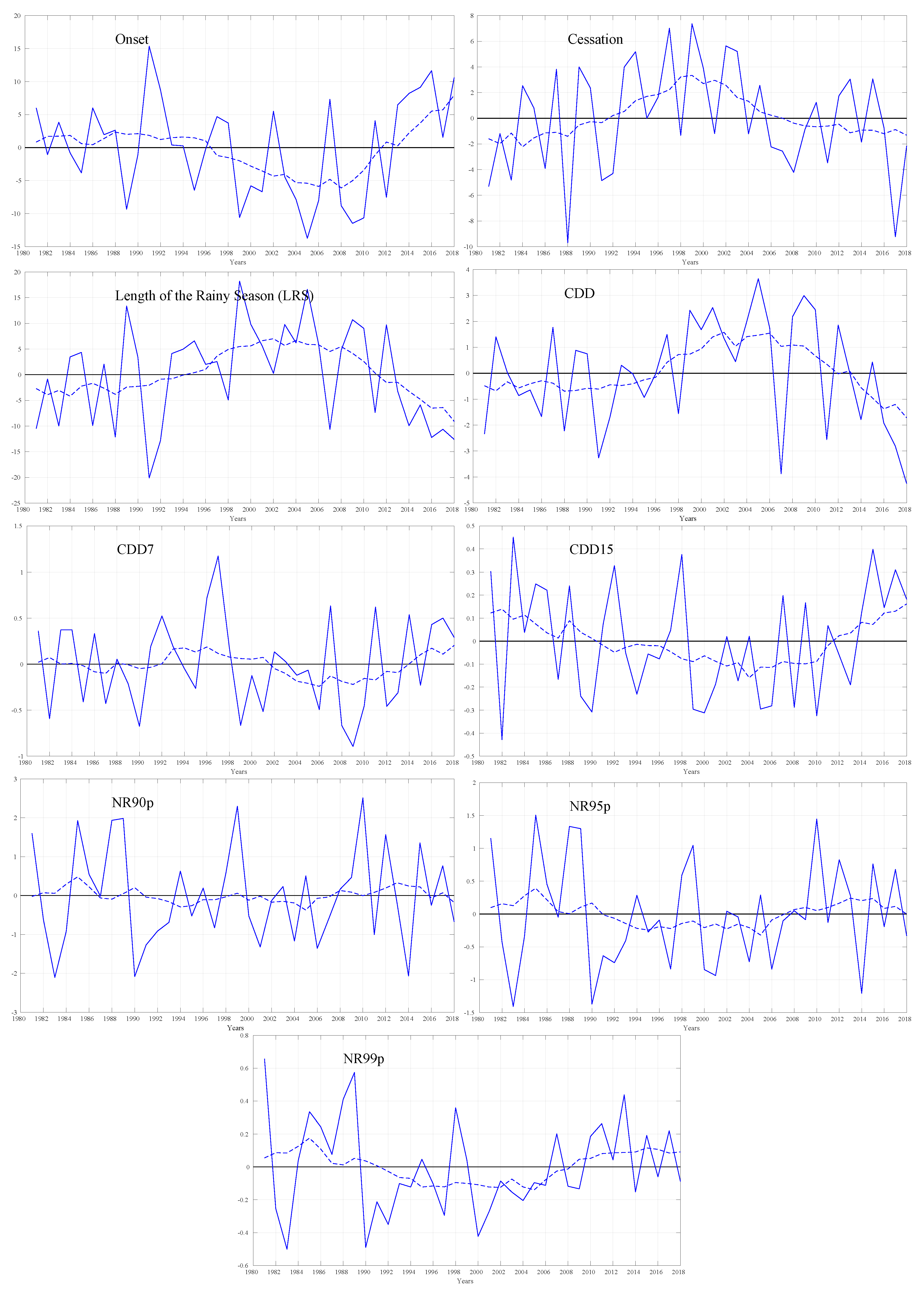
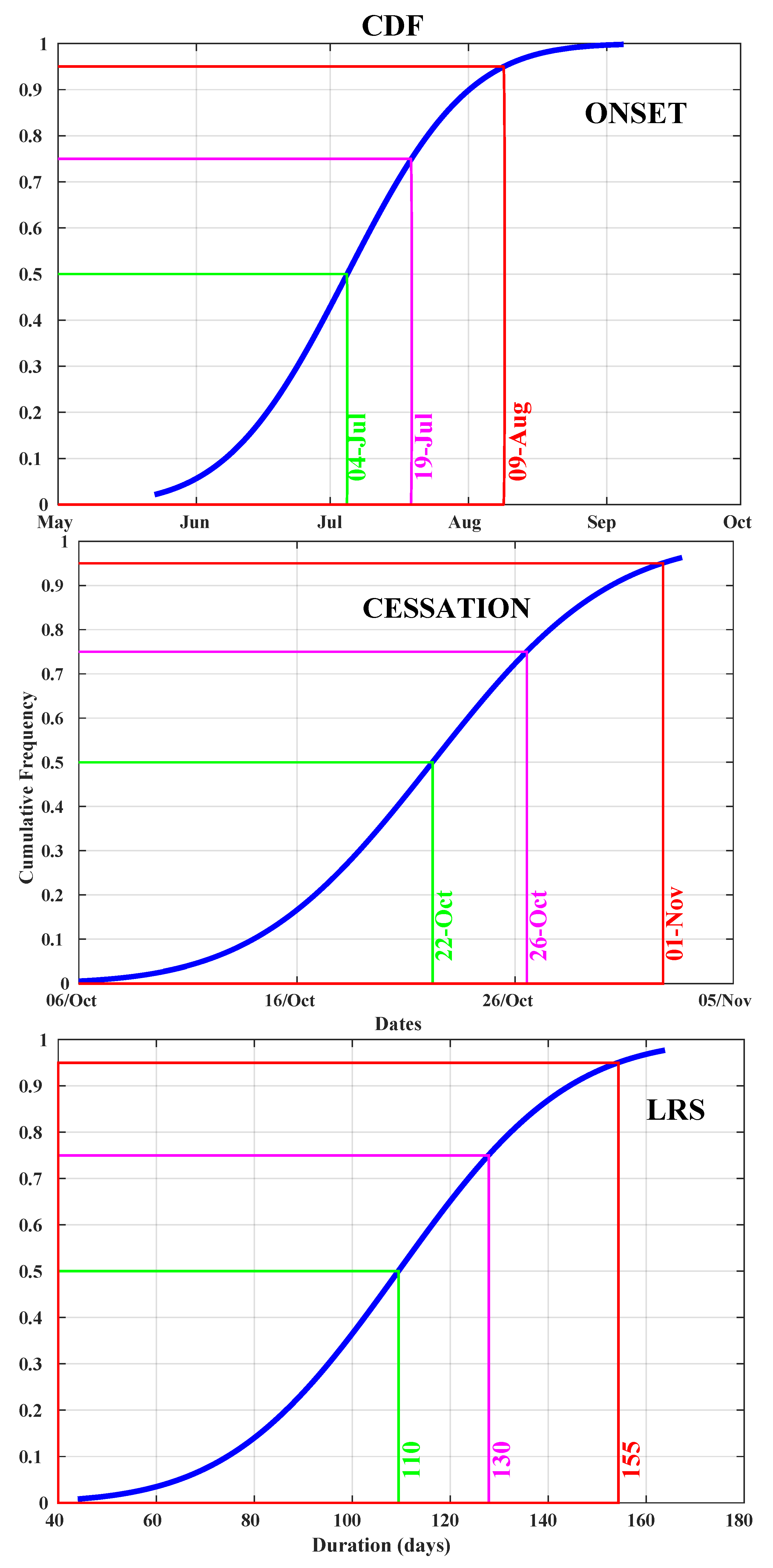
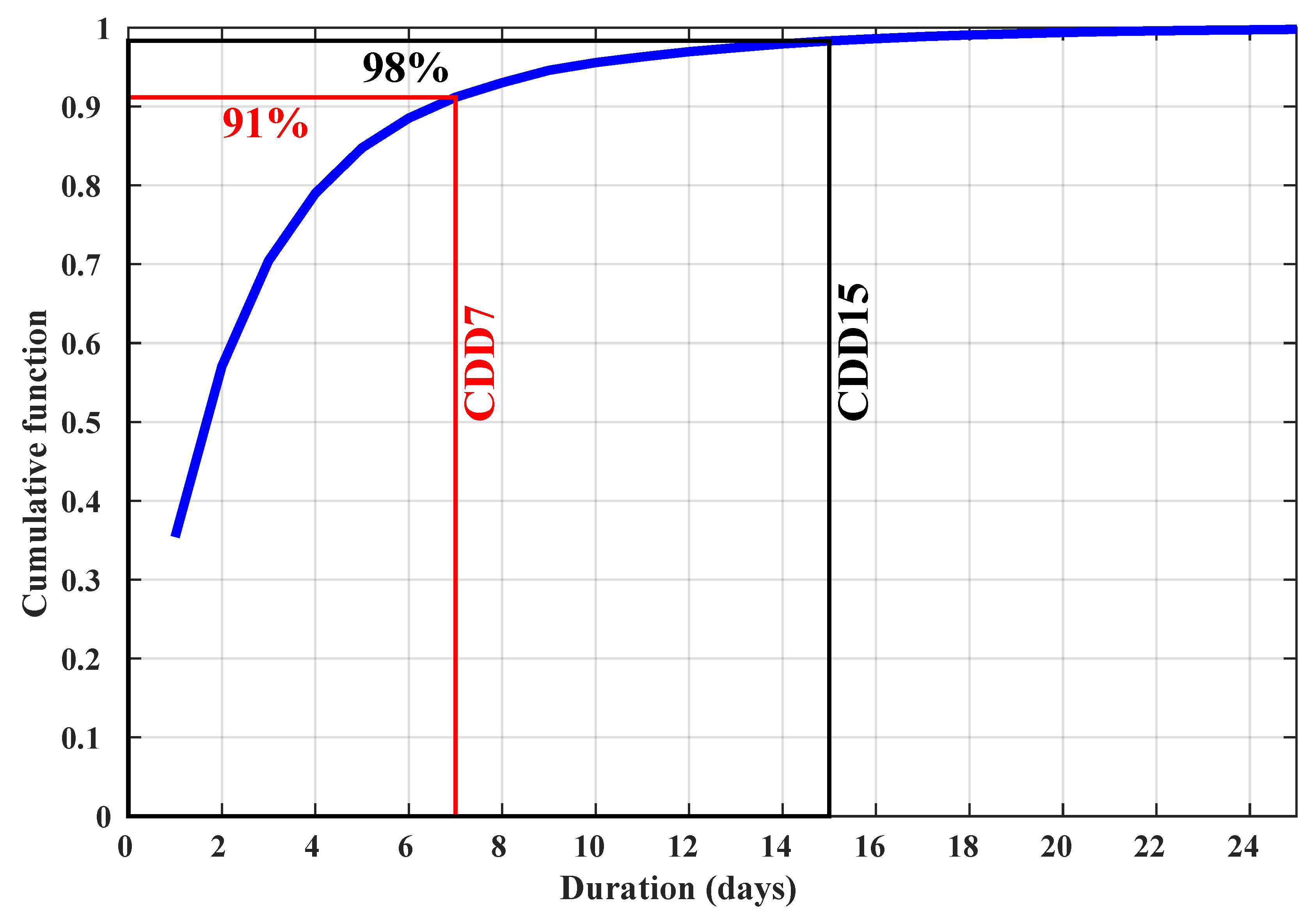
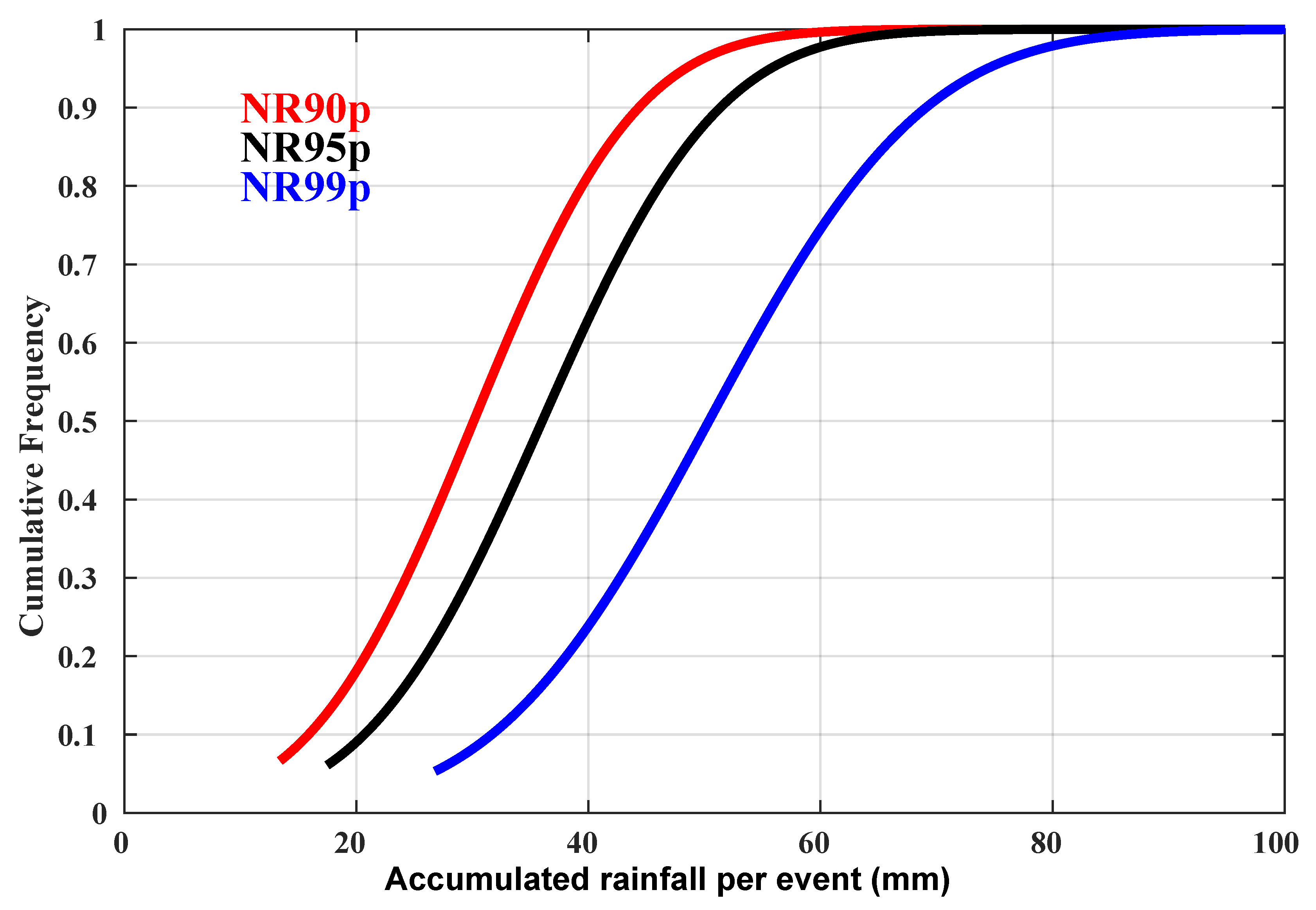

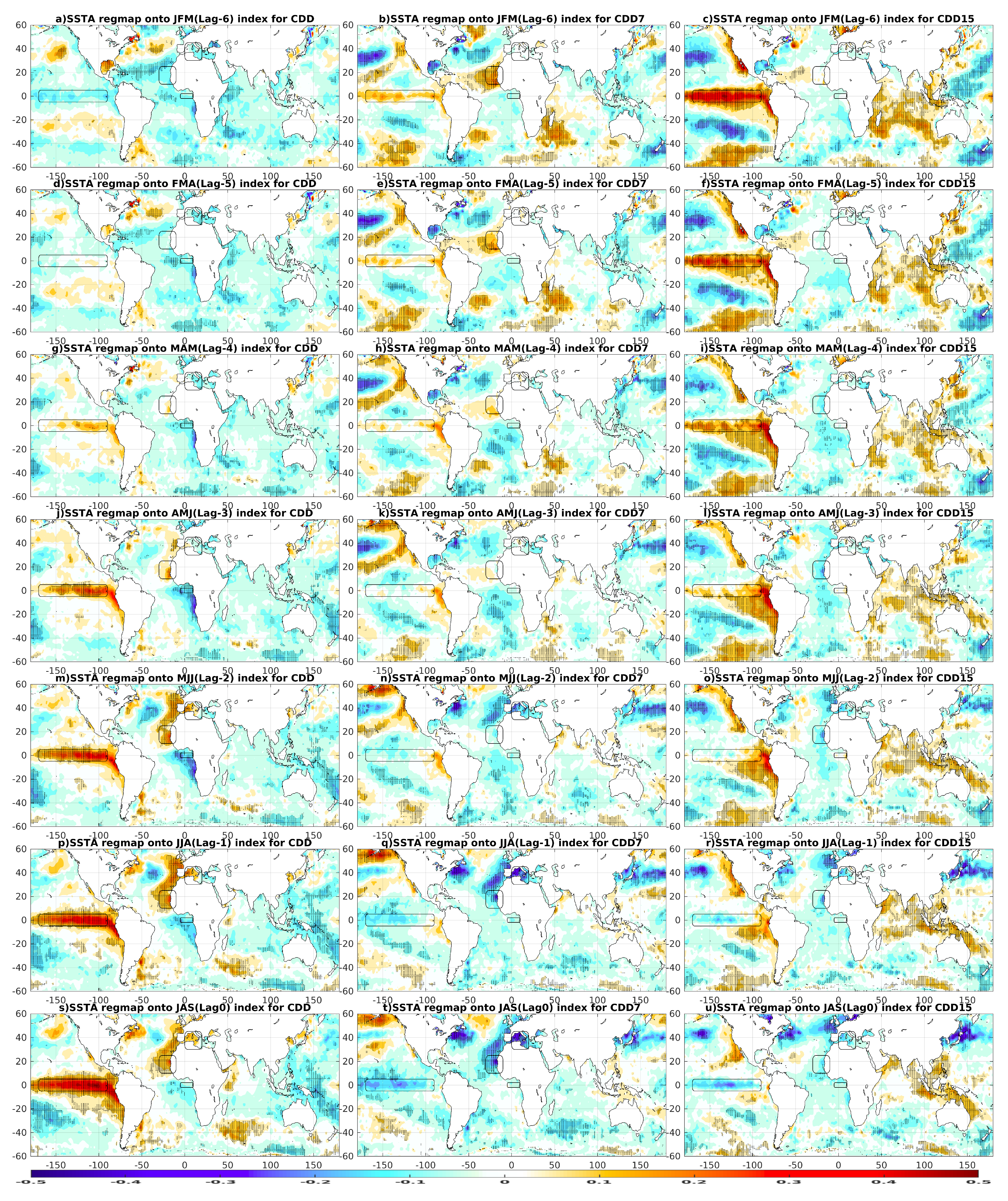
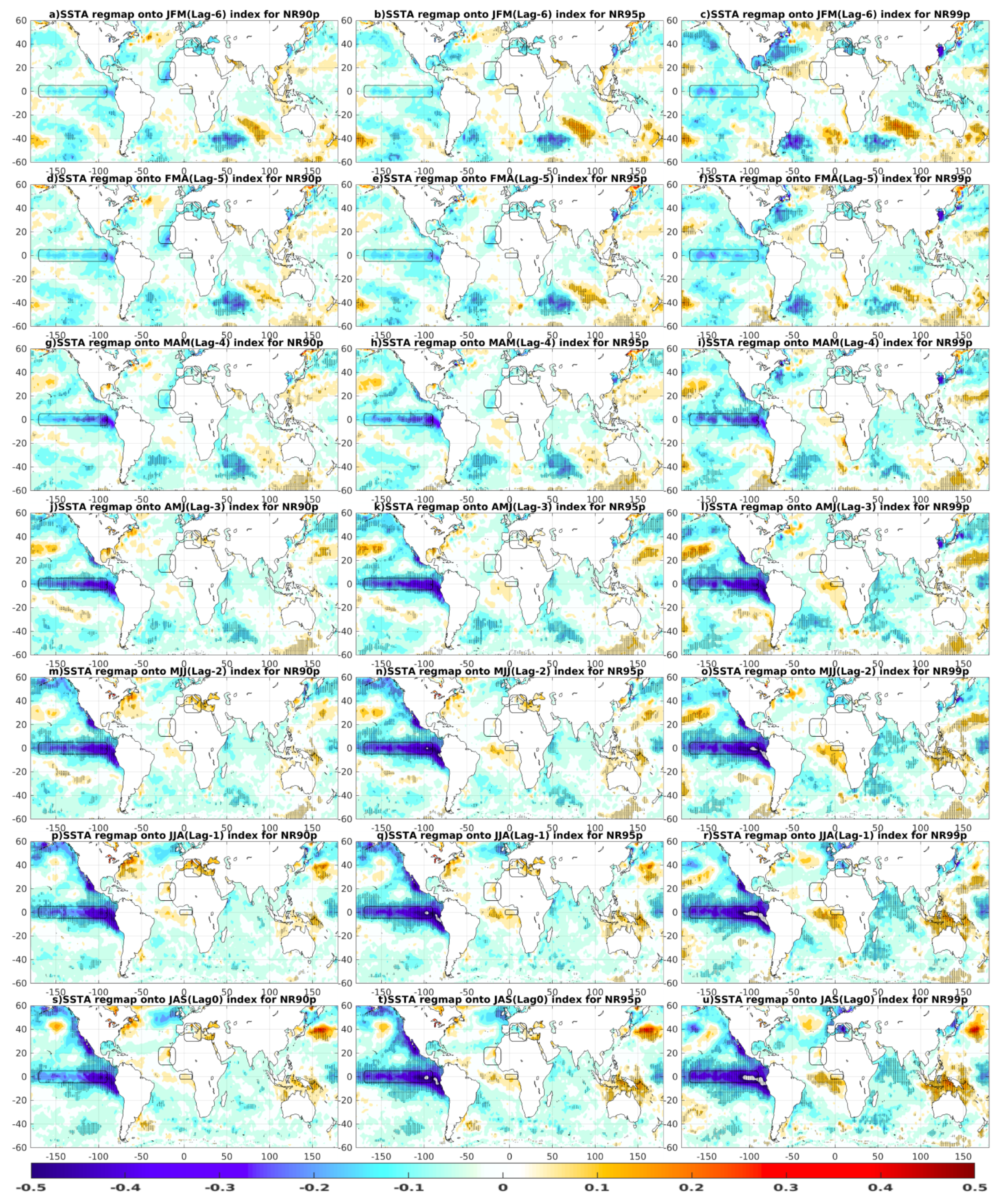
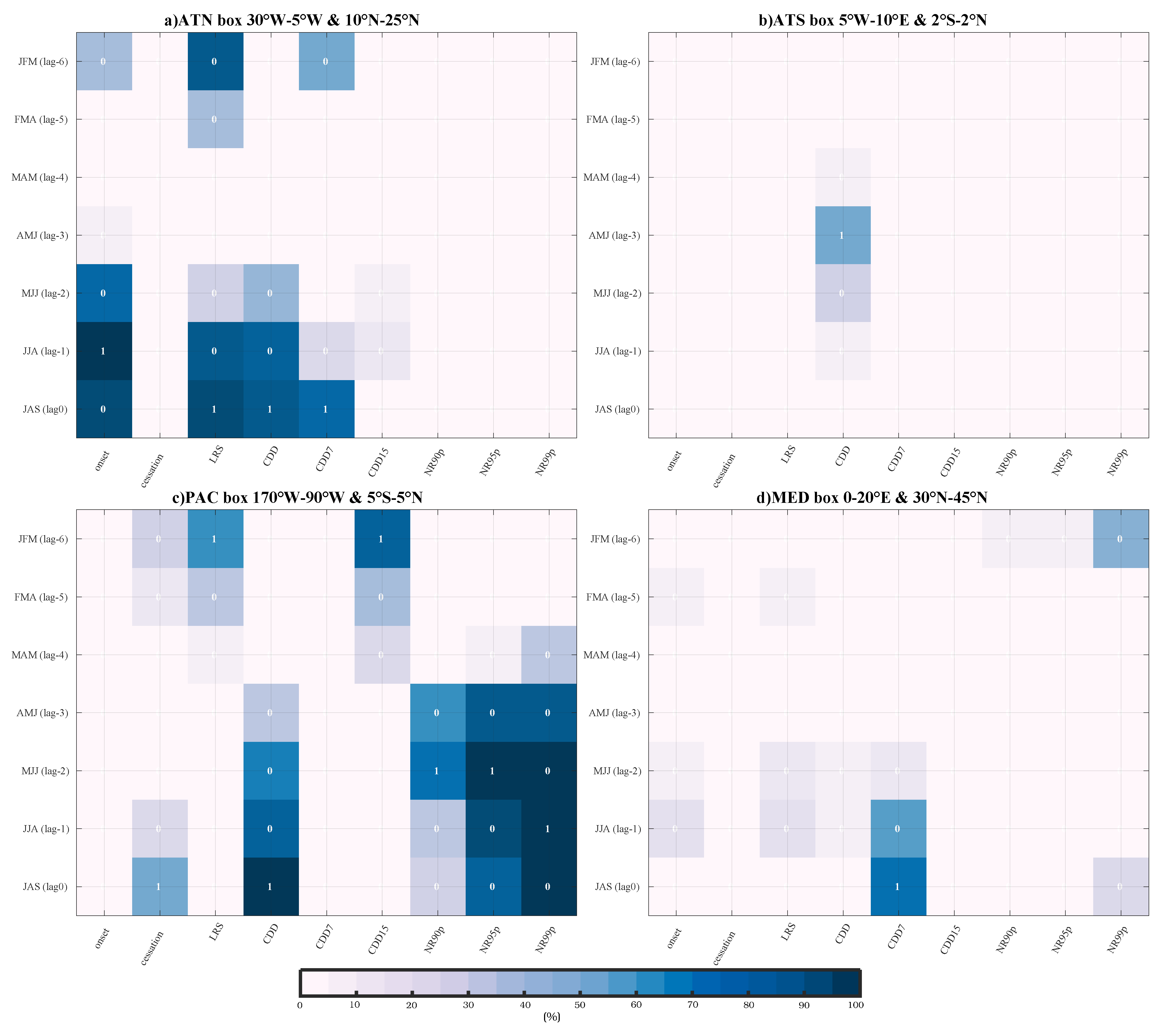
| Names | Indicators | Definitions | Units |
|---|---|---|---|
| wet | humid day during the rainy season | rainy day with at least 1 mm | mm/day |
| dry | dry day during the rainy season | day with less than 1 mm | mm/day |
| Onset | Start date of the rainy season | Wet day with at least 20 mm without any 10-day dry spell | Julian day |
| Cessation | End date of the rainy season | Dry spell lasting 20 days occurred after 1 September | Julian day |
| LRS | Length of the rainy season | End date minus start date of the rainy season | days |
| CDD | Consecutive dry days | All Durations of consecutive dry days | days |
| CDD7 | Consecutive dry days 7 days | Durations 7 Days of consecutive dry days | days |
| CDD15 | Consecutive dry days 15 days | Durations 15 Days of consecutive dry days | days |
| NR90p | Wet Day 90th percentile | Wet day with rainfall amount above 90th percentile | mm/day |
| NR95p | Wet Day 95th percentile | Wet day with rainfall amount above 95th percentile | mm/day |
| NR99p | Wet Day 99th percentile | Wet day with rainfall amount above 99th percentile | mm/day |
| Metrics | Trend | p-Value | Mean |
|---|---|---|---|
| Onset | −0.0788 | 0.563 | 7 July |
| Cessation | 0.1452 | 0.056 | 21 October |
| LRS | 0.2238 | 0.159 | 106 |
| CDD | 0.1099 | 0.0015 | 26.95 * |
| CDD7 | −0.0211 | 0.0111 | 2.56 ** |
| CDD15 | −0.012 | 0.0061 | 0.55 * |
| NR90p | 0.0379 | 0.056 | 5.31 |
| NR95p | 0.0105 | 0.4210 | 2.65 |
| NR99p | −0.0049 | 0.5802 | 0.53 |
Publisher’s Note: MDPI stays neutral with regard to jurisdictional claims in published maps and institutional affiliations. |
© 2022 by the authors. Licensee MDPI, Basel, Switzerland. This article is an open access article distributed under the terms and conditions of the Creative Commons Attribution (CC BY) license (https://creativecommons.org/licenses/by/4.0/).
Share and Cite
Touré, A.K.; Fall, C.M.N.; Diakhaté, M.; Wane, D.; Rodríguez-Fonseca, B.; Ndiaye, O.; Diop, M.; Gaye, A.T. Predictability of Intra-Seasonal Descriptors of Rainy Season over Senegal Using Global SST Patterns. Atmosphere 2022, 13, 1437. https://doi.org/10.3390/atmos13091437
Touré AK, Fall CMN, Diakhaté M, Wane D, Rodríguez-Fonseca B, Ndiaye O, Diop M, Gaye AT. Predictability of Intra-Seasonal Descriptors of Rainy Season over Senegal Using Global SST Patterns. Atmosphere. 2022; 13(9):1437. https://doi.org/10.3390/atmos13091437
Chicago/Turabian StyleTouré, Abdou Kader, Cheikh Modou Noreyni Fall, Moussa Diakhaté, Dahirou Wane, Belen Rodríguez-Fonseca, Ousmane Ndiaye, Mbaye Diop, and Amadou Thierno Gaye. 2022. "Predictability of Intra-Seasonal Descriptors of Rainy Season over Senegal Using Global SST Patterns" Atmosphere 13, no. 9: 1437. https://doi.org/10.3390/atmos13091437





